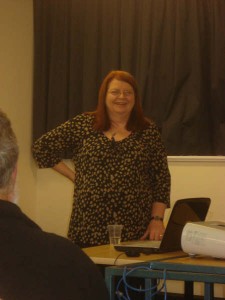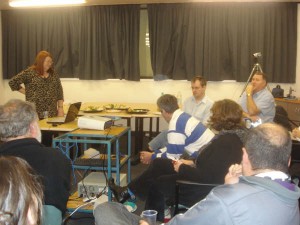Towards a National Science Communication Strategy (NSCS)
Background Information for Participants
Introduction
For a number of reasons, it is timely to examine the science communication landscape in Australia and to consider whether the status quo is a satisfactory situation. At the national level, there have been recent reviews of the National Innovation System, CSIRO Science Education Centres, and two areas within the Australian Department of Innovation, Industry, Science and Research (DIISR) – the Science Connections Program (SCOPE) and Questacon – The National Science and Technology Centre. The ABC, Australia’s national broadcaster, is currently undergoing a major public review phase. Furthermore a new national science curriculum is under development.
Australia is fortunate to have a range of quality organisations and individuals in the science communication ‘ecosystem’ and significant strengths to build upon. It is in Australia’s interest to work towards a more coherent approach to fully utilise all national assets.
Australia has significant strengths in science communication but the broad science communication effort is fragmented and uneven across the country. This problem was identified in the 2003 Prime Minister’s Science, Engineering and Innovation Council (PMSEIC) study into Science Engagement and Education that recommended a ‘national framework-local action’ approach.
A DIISR Steering Committee comprising the Deputy Secretary, the Chief Scientist, the Chief Executive of CSIRO, the Director of Questacon – The National Science and Technology Centre, and a representative of The ABC, together with supporting officers, has met to discuss the need for a national science communication strategy.
As part of the post-Budget re-structuring of the DIISR, the Questacon division of the Department has been asked to work towards the development of a national strategy which will encourage a more coordinated approach to science communication across Australia. Questacon now has responsibility for the SCOPE program, which includes a number of national initiatives such as National Science Week. Questacon has been asked to design a replacement program for this lapsing program, as part of a national science communication strategy.
The Goal
As previously articulated (PMSEIC 2003), Australia’s success as a 21st century knowledge society will depend on having an excellent education system, a technologically-skilled workforce, a science-literate community and well-informed decision makers.
Science communication activities supports
- the development of an adequate supply of well-qualified scientists, mathematicians engineers and technologists;
- the development of a society that is informed and excited about science, values its importance to the country’s economic and social well-being, feels confident in its use and supports a representative well-qualified scientific workforce; and
- the provision of trusted quality information for opinion formers, policy developers and decision makers.
It will be important for a national science communication strategy to:
- embrace a broad definition of science communication to encompass science, mathematics, engineering and technology, as well as to incorporate the perspectives of the humanities and social sciences;
- draw from the experience and findings of similar initiatives, including overseas initiatives;
- consider how current assets and capability (at national, state/territory and local levels) could better be aligned, connected, developed and delivered in order to achieve greater outcomes and impacts in these areas;
- develop a “national framework – local action” model which takes into account relevant policy initiatives at federal/state/local levels, which optimises opportunities for existing and potential players and investors to contribute, and which builds cooperation through questions such as “What can I do? What can you do? What can we do together?”;
- address issues of leadership, facilitation and coordination which will be key to the success of any forward strategy and implementation plan;
- be practical, providing improved outcomes which can be achieved within the short term (next 12 months), within the medium term (next 5 years), and within existing and realistic resource and budget parameters.
The Process
The Steering Committee will propose a more coordinated approach for science communication to Senator the Hon. Kim Carr, Minister for Innovation, Industry, Science and Research at the end of September 2009.
In order to inform the development of a national policy framework, a forward strategy and implementation plan, a series of key stakeholder discussions are planned during July and August to obtain broad input from a range of organisations and individuals with an interest in science communication. These consultations will be led by Professor Graham Durant as a member of the Steering Committee, or senior secretariat officers.
The consultations will not involve all individuals and organisations with an interest in science communication. Rather, a sample of individuals and organisational representatives, who are associated with state/local science communication initiatives, are being invited to participate in a small group discussion to provide:
- insight into the state/local science communication scene
- suggestions on how state/local initiatives could benefit and develop through better coordination or through linking into a national framework
- practical ideas on actions which could be taken in the short term (during the next 12 months) and in the medium term (over the next five years)
In addition to stakeholder discussion sessions and interviews, the Steering Committee would welcome further input by way of a written submission. Written submissions must be received no later than 24 August 2009 via mail to:
The Secretariat
National Science Communication Strategy
Questacon – The National Science and Technology Centre
Department of Innovation, Industry, Science and Research
PO Box 5322 Kingston ACT 2604
Alternatively, written submissions can be emailed no later than 24 August 2009 to sciencecommunications [at] innovation.gov.au
Towards a National Science Communication Strategy (NSCS)
Agenda
- Introduction
- An opportunity to introduce ourselves and to clarify the process to develop a national science communication strategy
- State Scenario
- Outlining the state of play for science communication in your state
- Who are the key players?
- What are the major activities?
- Who are collaborating (at local/state/national levels) to deliver science communication activity?
- How well is this scenario working and what could be improved?
- National Framework – Local Action
- What mechanisms would support and sustain more effective and extensive cooperation, involvement and investment?
- The Way Forward
- What are some practical ideas that we can action in the next 12 months, in the next 5 years?
- Summary of Discussions
- Where to from here?


